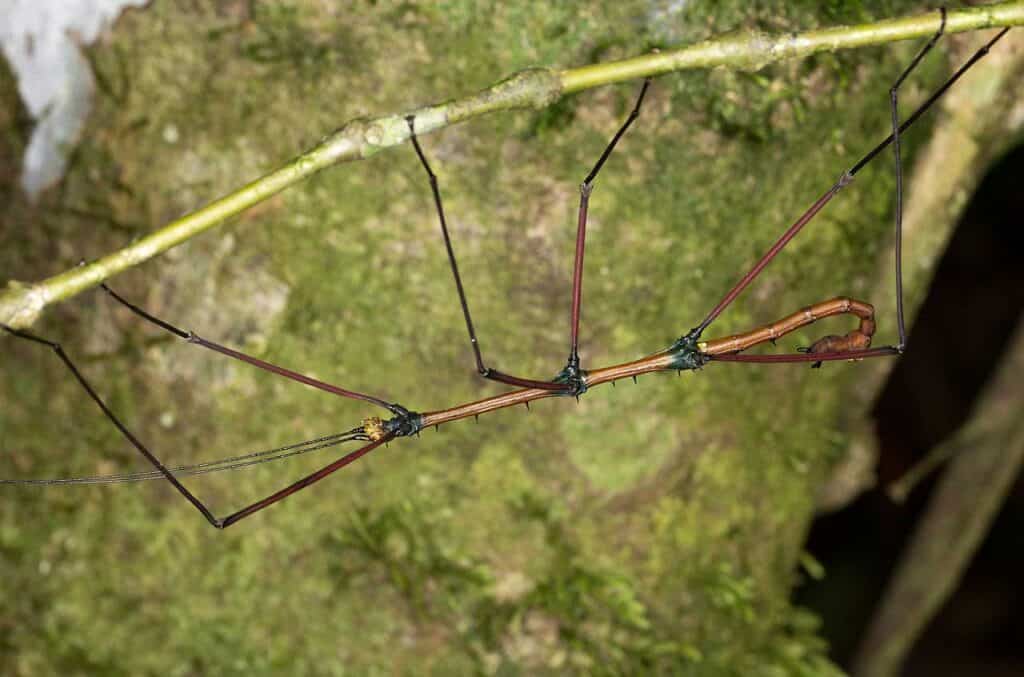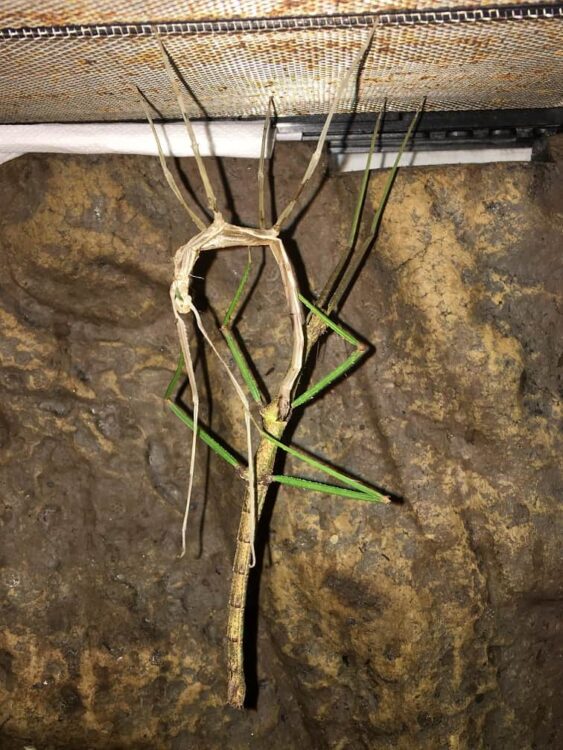Table of Contents
If you already own a stick insect(s), you’ve more than likely seen it before.
Your stick insect has decided to hang upside down in its cage. This makes a lot of first-time stick insect owners uncomfortable because they think something is wrong with them. During this time, the insects will not move much. Indeed, many novice owners think that their stick has even died.
But it hasn’t.
The average stick insect will hang itself upside down between six and nine times throughout its life. This is the moulting process and it is essential to the growth and development of your stick insect.
Let us take a look at the moulting process and how you can help your pet when it is hanging upside down.
For more advice and information on keeping and looking after stick insects, check out my ebook on Amazon click here
(opens in a new tab).

What Happens When Stick Insects Hang Upside Down?
As mentioned above, a stick insect will moult on average between six and nine times in its lifetime. Each time they do this though they grow larger until becoming fully-fledged adults.
The physical process requires a lot of energy and your stick insect will be extremely fragile when eventually returning to the ground. What they are doing in the process is essentially removing their old skin by pulling out of it.
You can imagine how difficult that must be.
It is a process that is required for growth and healing though. For example, stick insects can lose their legs as a result of overcrowding, improper moulting, or incorrect handling on your part. But these legs can grow back through moulting.
as a result of overcrowding, improper moulting, or incorrect handling on your part. But these legs can grow back through moulting.
Why the Leg Regrowth Process is a Big Part of Moulting
The second main reason moulting is so important is that it allows the stick insect to heal. Stick insects do not die upon losing any of their legs as they have special muscles that close the wound at the point the leg meets the body.
Each time they lose a limb, they have an opportunity to regrow that leg again. This can happen even if they lose the same leg repeatedly.
In saying that though, when they get through their final moult and become adults, you have to be extra careful with them as they won’t have another chance to regrow that leg if it comes off.

Why Do Stick Insects Hang Upside Down to Moult?
The insects hang upside down by anchoring their old skin. They are using it almost like a grow bag because when they attach their skin to an elevated point in their enclosure they are using that leverage to pull their whole body out of the old skin.
Do be aware that this is why they need a large vertical space to moult successfully. Always have more vertical space in your cage for this reason.
You should know though that improper moulting could mean your stick insect dying or coming out of the old skin deformed, which will more than likely lead to their death anyway.
Is Your Stick Insect Sticking to the Top of the Cage?
One of the biggest myths about stick insects is that they can stick to the top of the cage to moult. For a long time, this is what scientists believed about them. But the latest research has put an end to that idea.
The truth is that they are actually using grip to hang themselves from the top of your cage. The University of Cambridge found out that stick insects have deployable hairy pads that they can use to drip on any surface. Even the smallest amount of suction can allow them to grip the surface.
that they can use to drip on any surface. Even the smallest amount of suction can allow them to grip the surface.
These pads are only visible when the stick insect is hanging upside down to moult because they have no reason to use them at any other time.
Just a quick note for the novices: stick insects are not known by that name because they stick to things as just described for the moulting process. It is because they look like little sticks or branches.
Do You Need to Do Anything When Your Stick Insect is Hanging Upside Down?
You do not normally need to do anything, other than leave your stick insect alone. Sometimes the moulting process can take a few days. During this time, they will not do anything, including move or eat.
However, when they eventually drop down they will be extremely fragile and should not be touched for a few days after that. You may still coax them onto your hand, but even this should be performed by someone who truly knows what they are doing.
Be aware that some stick insects will hang themselves upside down and moult improperly because of the conditions.
Novice stick insect owners typically run into this problem when they don’t make the conditions humid enough. More humidity means your pet will have an easier time getting out of their skin.
Some stick insects will have problems getting out of their old skin due to the conditions, which may cause them to lose legs in the process.
The less humidity there is the more rigid the skin, which can lead to difficulties when trying to pull out of the old skin.
You have two options to counter this problem.
First, change the conditions and artificially create something akin to your pet’s native environment by adding heat lamps or mats. You will need to look up your species prior to doing this to see which conditions they prefer the most.
The second option is to mist your stick insect after it has hung itself upside down. The mist will increase the humidity and make their skin suppler, so they shouldn’t have any problems pulling themselves out of their old skin.
Last Word – Your Stick Insect is Growing
The reason your stick insect is hanging upside down is because it is growing. It will go through this process several times, getting larger after each moult. Furthermore, it will also be able to regenerate limbs if need be.
Make sure you have the right conditions for them to moult successfully. Look up your species and do your best to replicate their natural conditions.
By doing this you will decrease the chances of it dying or being deformed.

